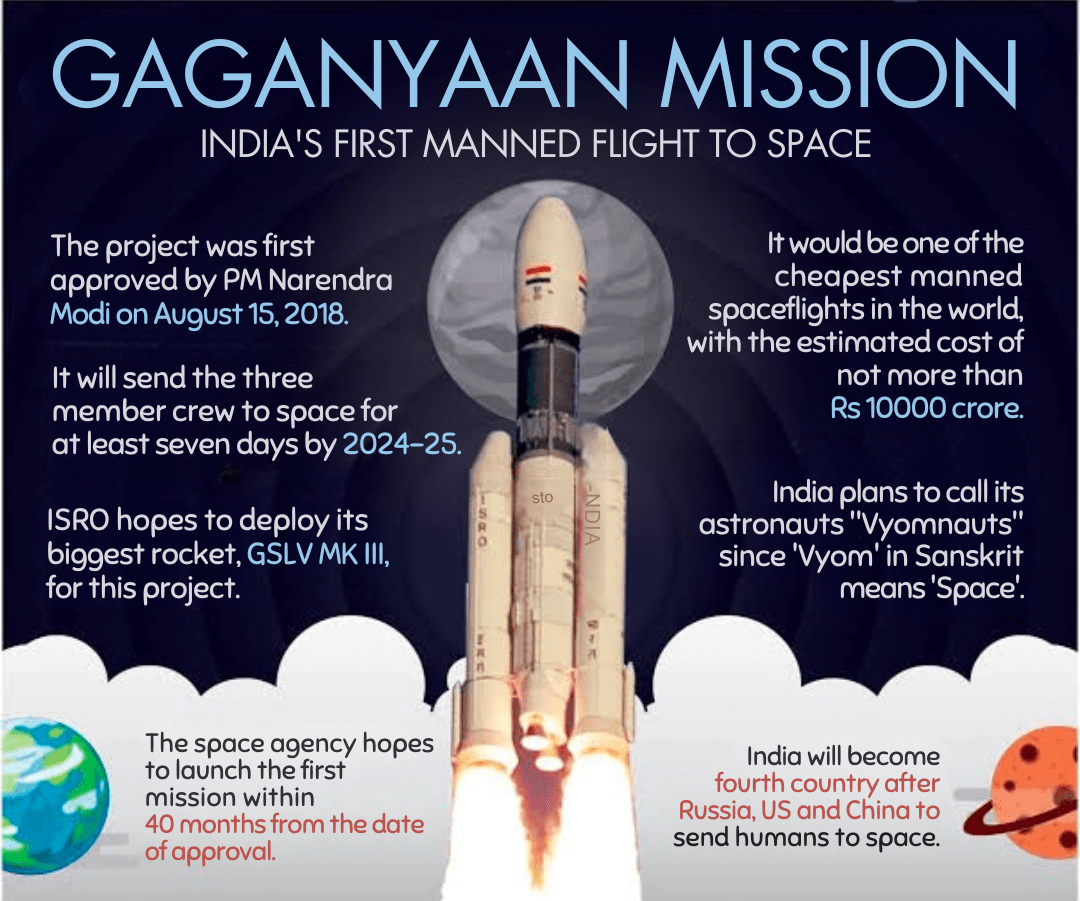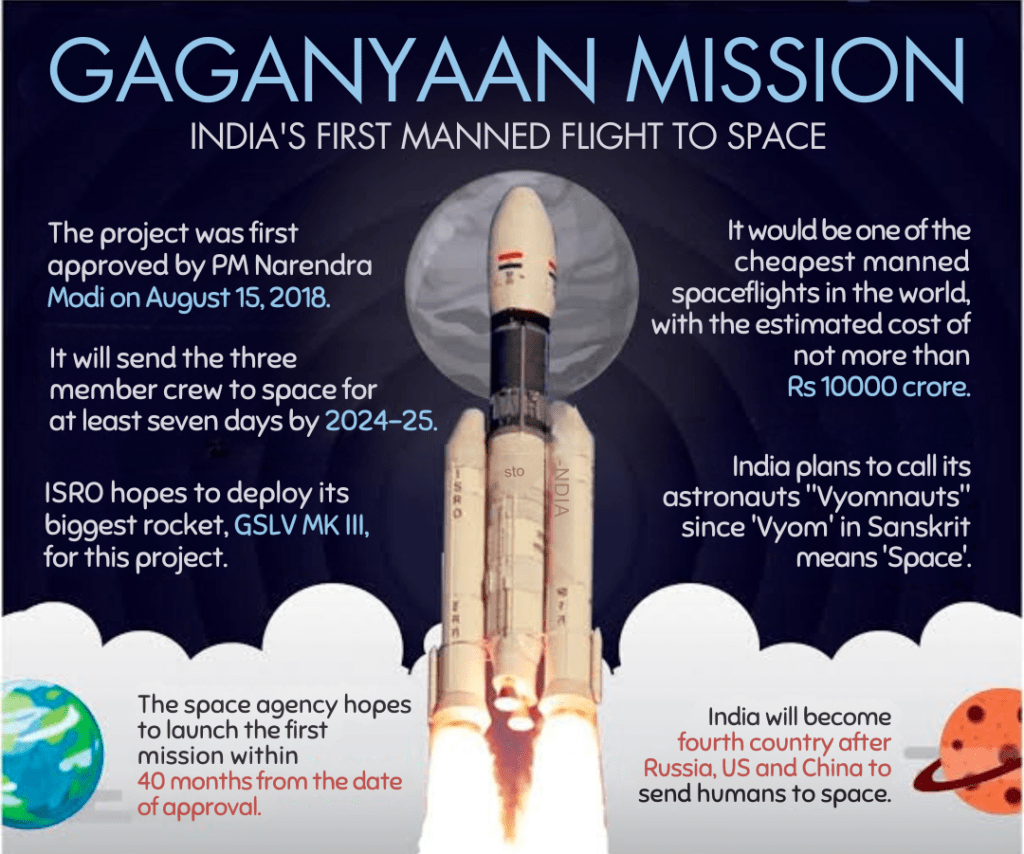
2.Gaganyaan Mission(ISRO):
In news:
● India has selected two ‘Gaganyatris’ for NASA’s Axiom-4 mission to the
International Space Station.
About Gaganyaan Mission:

1.Space-borne Assistant and Knowledge Hub for Crew Interaction (SAKHI) App:
● Developed by: Vikram Sarabhai Space Centre (VSSC), ISRO, located in
Thumba, Thiruvananthapuram.
● Purpose: A multifunctional app designed to support astronauts on the
Gaganyaan mission with tasks such as accessing technical information and
facilitating communication.
● Features: Monitors astronaut health, ensures connectivity with Earth, and
manages dietary schedules.
Vyommitra:
● Developed by: ISRO Inertial Systems Unit, Thiruvananthapuram.
● Design: Half-humanoid with a torso but no legs.
● Purpose: Simulates human functions for space missions before real astronauts
launch.
● Features: Resembles a human with facial expressions, speech, and sight.
● Digital Twin: Will undergo computer simulations to test control systems in
microgravity conditions
● Vyommitra will be part of the first unmanned test flight before the crewed
Gaganyaan mission, expected in 2024.
● It will simulate human functions in space.
● It will test whether the systems are functioning correctly.
Gaganyaan Mission:
● Objective: India’s project to send a 3-day manned mission to Low Earth Orbit
(LEO) at 400 km with a crew of 3 and return them safely to Earth.
● Approval: Includes two unmanned missions and one manned mission, approved
by the Government of India.
● Timeline: First manned spaceflight expected in 2024.
● Significance: Success will place India among elite nations (US, Russia, China)
with human spaceflight capabilities.
Objectives:
● Immediate Aim: Demonstrate indigenous capability for human space flights.
● Long-Term Goal: Establish a foundation for a sustained Indian human space
exploration program.
Privilege Motion:
In news: The Congress has filed a privilege motion in the Rajya Sabha against
Home Minister Amit Shah, accusing him of misleading the House about the
Wayanad landslides.
About Privilege Motion:
● Parliamentary Privilege:
○ Refers to the rights and immunities of Parliament and MPs necessary for
performing their functions as per the Constitution.
○ Defined by Parliament under Article 105 of the Constitution, but no specific
law has been enacted; governed by British Parliamentary conventions.
● Breach of Privilege:
○ Occurs when there is a violation of the privileges of MPs or Parliament.
○ Includes actions like casting reflections on MPs, Parliament, or its
committees.
● Privilege Motion:
○ A motion moved by any member of either House alleging a breach of
privilege.
○ Must meet two conditions:
- The matter should be recent.
- The matter requires intervention by the Council.
● Procedure:
○ The Speaker of the Lok Sabha or Chairman of the Rajya Sabha is the first
to review the privilege motion.
○ They can either decide on it themselves or refer it to the Privileges
Committee of Parliament.
○ The Privileges Committee, consisting of ten members and a Chairman
appointed by the Rajya Sabha Chairman, examines the motion.
○ If the Speaker/Chairperson approves under Rule 222, the member
concerned is allowed to make a brief statement.
4.INFLATION(Context, Definition, Types, How
Calculated, Causes, Effects, Solution etc.)
Context:
● Food inflation remains a major concern, even as core inflation hits a record
low at 3.1%.
● In June, food inflation spiked, raising the Consumer Price Index (CPI)
inflation to 5.1%, up from 4.8% in May, primarily driven by increasing prices
of vegetables, cereals, milk, and fruits.
● Despite a favorable base effect, food inflation climbed to 9.4%, with
vegetable inflation soaring to 29.3%.
● TOP inflation soared to 48.4%, driven by onion prices at 58.5% and
potatoes at 57.6%. However, tomato inflation eased to 26.4%, down from
41.3%.
● Non-TOP vegetables experienced a rise in inflation, increasing to 19.7%
from 18.8%.
● Rural inflation increased to 9.2% from 8.6%, while urban inflation was more
stable, rising by 20 basis points to 8.8%.
INFLATION:
About:
● Inflation refers to the rise in prices of common goods and services, such as food,
clothing, and housing. It is measured as the average change in the price of a
basket of goods over time and indicates a decrease in the purchasing power of a
country’s currency.
For example:
Currently, 1 liter of milk costs Rs. 50, up from Rs. 40 a year ago.
This represents an increase of Rs. 10, meaning Rs. 40 now only buys 800 ml of milk.
Using the formula ((50−40)/40)×100=25((50-40)/40) \times 100 =
25((50−40)/40)×100=25,
we can conclude that milk prices have inflated by 25% compared to last year.
Types:
● Monetary Inflation
Monetary inflation occurs when excessive money is printed by the RBI.
● Open Inflation
Open inflation refers to a situation where prices rise without any
government-imposed price controls.
● Suppressed/Repressed Inflation
Suppressed or repressed inflation happens when the government enforces price
controls and rationing during crises, like wars or pandemics. Once these
measures are lifted, prices surge.
● Headline Inflation
Headline inflation measures total inflation in an economy, typically represented
by the Consumer Price Index (CPI) or Wholesale Price Index (WPI).
● Structural Inflation
Structural inflation is inherent to a specific economic system, requiring a
complete policy overhaul to eliminate it.
● Creeping Inflation
Creeping inflation refers to a low inflation rate (up to 4%) that is considered safe
and beneficial for job creation and economic growth.
● Walking/Trotting Inflation
Walking or trotting inflation occurs when the inflation rate is moderate, ranging
from 4% to 9%.
How inflation calculated
In India, inflation is primarily measured by:
● Wholesale Price Index (WPI): Calculated monthly by the Ministry of Commerce
& Industry.
● Consumer Price Index (CPI): Determined by averaging price changes for items
in a predetermined basket of goods.
● Producer Price Index: Measures average changes in selling prices received by
domestic producers over time.
● Commodity Price Indices: A fixed-weight index of selected commodity prices,
based on either spot or futures prices.
● Core Price Index: Tracks consumer prices excluding volatile food and energy
prices, indicating underlying inflation trends.
● GDP Deflator: Measures general price inflation in the economy.
Causes:
1.Demand-Pull Inflation
Demand-pull inflation occurs when aggregate demand increases due to factors such as:
● Fiscal stimulus
● Population growth
● Higher net exports
● Monetary stimulus
● Policy decisions
2.Cost-Push Inflation
Cost-push inflation arises from rising production costs, which can be caused by:
● Increases in employee salaries
● Rising raw material prices
● Higher profit margins for firms
● Increased import prices
Effects of Inflation:
● Redistribution of Income and Wealth
Inflation redistributes income and wealth, benefiting some groups while
disadvantaged others.
● Borrowers vs. Lenders
Borrowers gain while lenders lose. For instance, if a debtor borrows Rs. 100 at a
5% interest rate, they repay Rs. 105. If inflation exceeds 5%, the real value of the
repayment declines.
● Producers vs. Consumers
Consumers face reduced purchasing power and must pay more for goods and
services, benefiting producers while harming consumers.
● Flexible Income vs. Fixed Income Groups
Flexible income groups, like self-employed individuals, adjust to inflation and
remain unaffected, whereas fixed-income groups, such as daily wage earners,
suffer as their purchasing power diminishes.
● Debenture Holders vs. Issuers
Bond issuers benefit while bondholders lose, as fixed bond rates often fail to
keep up with inflation.
● Equity Holders Income
Equity holders benefit from higher profits during inflation, leading to increased
income.
Solutions:
- Monetary Policy: The Reserve Bank of India (RBI) controls inflation through
monetary policy by adjusting key interest rates, such as the repo rate, to
influence money supply and credit. The RBI also conducts Open Market
Operations (OMO) by buying or selling government securities, impacting the
money supply and inflation. - Fiscal Policy Measures: The government manages inflation through fiscal
policies like taxation and public spending. Higher taxes can reduce disposable
income, curbing demand and inflationary pressures. - Food Price Management: To address rising food prices, the government
implements schemes like the Minimum Support Price (MSP) and the Public
Distribution System (PDS) to manage supplies and prices. - Buffer Stock Operations: The government maintains buffer stocks of essential
commodities to stabilize prices during shortages, which helps mitigate inflationary
pressures. - Exchange Rate Management: The government oversees and manages the
exchange rate to maintain competitiveness in international trade. A stable
exchange rate helps control import costs, contributing to price stability.
Comparison of WPI and CPI

Related Concepts
- Deflation : Deflation is a persistent decline in the general price level, essentially
the opposite of inflation, characterized by a negative rate of change in the price
index. - Disinflation : Disinflation occurs when inflation rises at a slower rate. For
instance, if inflation was 6% last month and dropped to 5% this month, it is
termed disinflation. - Reflation : Reflation is a government strategy to intentionally increase inflation to
stimulate the economy, typically implemented to counteract deflationary
conditions.
Comparison between Core and Headline Inflation:
| CORE Inflation | HEADLINE Inflation |
| Core inflation measures the persistent increase in the general price level of goods and services, excluding volatile items like food and energy. By focusing on stable prices, it provides a clearer long-term trend in inflation, aiding in the formulation of long-term policies. | Headline inflation encompasses the total inflation in an economy, including all goods and services purchased by consumers. It reflects the overall rate of price change over time. In the RBI’s Flexible Inflation Targeting (FIT) framework, the CPI (Combined) is used to measure headline inflation. |
Phillips Curve
● The Phillips Curve illustrates the inverse relationship between unemployment
and inflation, indicating that as unemployment decreases, inflation tends to
increase, and vice versa. Named after economist A.W. Phillips, who introduced
this theory in 1958.
Stagflation and Phillips Curve
● Stagflation, a combination of stagnation and inflation, describes an economic
situation where low economic growth coincides with rising prices.
● Typically, higher inflation is associated with robust economic growth, making
stagflation a rare phenomenon and an exception to the Phillips Curve.
Way forward:
● Amidst inflation worries, collaboration between the government and RBI is
crucial. Actions might include stabilizing food prices, enhancing supply chain
efficiency and adopting a prudent monetary policy.
Inflationary effects are unevenly distributed across the economy. Unexpected
inflation can harm the economy by increasing market volatility and complicating
long-term budgeting for businesses. Conversely, moderate inflation can be
beneficial, fostering job creation and economic growth.
5.Governor should be a bridge between Centre and
State
In news:
● On August 2, Prime Minister Narendra Modi urged Governors to effectively
bridge the Centre and State governments.
● He addressed a two-day Conference of Governors, inaugurated by President
Droupadi Murmu, hosted at Rashtrapati Bhavan.
● The Prime Minister emphasized that the Governor’s role is crucial for the welfare
of people within the constitutional framework, especially in tribal areas.
About Governor :
Appointment:
● The President of India appoints the Governor of a State by warrant for a five-year
term.
● The Governor is not elected by the public or a special electoral college.
Qualifications:
● Must be an Indian citizen.
● At least 35 years old.
● Conventionally, the Governor should be an outsider who does not reside in the
state where appointed.
● The President must consult with the state’s Chief Minister when appointing a
Governor.
Constitutional Position:
● Article 153: Requires the appointment of a Governor for each state. The 7th
Amendment allows one person to be Governor of multiple states.
● Article 154: Grants the Governor executive power over the state, to be exercised
directly or through subordinate officers, in accordance with the Constitution.
● Article 163: Establishes a council of ministers, led by the Chief Minister, to assist
and advise the Governor, except when the Governor acts at his discretion.
● Article 164: States that the council of ministers is collectively responsible to the
state’s legislative assembly, forming the basis of the state’s parliamentary
system.
Powers:
● The Governor has similar Executive, Legislative, Financial, and Judicial
authorities as the President of India.
● However, the Governor’s powers are limited compared to the President, lacking
military, diplomatic, and emergency authorities.
